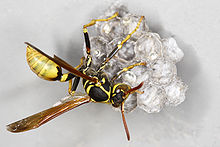| Mischocyttarus | |
|---|---|
 | |
| Western paper wasp ( Mischocyttarus flavitarsis ) building a nest | |
| Scientific classification | |
| Domain: | Eukaryota |
| Kingdom: | Animalia |
| Phylum: | Arthropoda |
| Class: | Insecta |
| Order: | Hymenoptera |
| Family: | Vespidae |
| Subfamily: | Polistinae |
| Tribe: | Mischocyttarini |
| Genus: | Mischocyttarus Saussure, 1853 |
| Species | |
>200 species | |
Mischocyttarus is a very large, primarily Neotropical genus of social wasps with a few species found also in the Nearctic region. It is the only member of the tribe Mischocyttarini; [1] the asymmetrical tarsal lobes of Mischocyttarus separates it from the tribe Epiponini. Mischocyttarus is the largest genus of social wasps, containing over 200 species and subspecies. [1] Mischocyttarus wasps build a relatively simple, single comb nest. Sometimes, the nest is built within a meter of the nest of Polistes carnifex . [2] Foraging adults bring nectar and small caterpillars back to the nest to feed to the developing larvae which are individually housed in separate cells in the nest. [3] Not all nests have a female with developed ovaries. [2] Their biology is similar to that of species in the genus Polistes . However, Mischocyttarus appear to show considerably more social and reproductive flexibility than Polistes.
